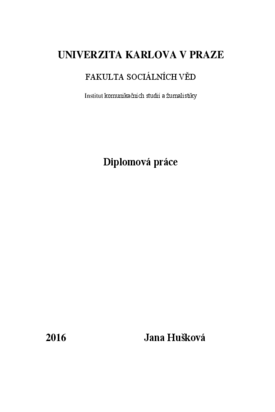Krize na Ukrajině ve zpravodajství ČTK v porovnání se zpravodajstvím ČT na vybraných událostech z let 2013 a 2014
The Ukrainian crisis in the news coverage made by ČTK and its comparison with ČT news with focus on crucial events within the conglict
diplomová práce (OBHÁJENO)

Zobrazit/
Trvalý odkaz
http://hdl.handle.net/20.500.11956/75867Identifikátory
SIS: 166956
Katalog UK: 990020939960106986
Kolekce
- Kvalifikační práce [19618]
Autor
Vedoucí práce
Oponent práce
Lokšík, Martin
Fakulta / součást
Fakulta sociálních věd
Obor
Žurnalistika
Katedra / ústav / klinika
Katedra mediálních studií
Datum obhajoby
23. 6. 2016
Nakladatel
Univerzita Karlova, Fakulta sociálních vědJazyk
Čeština
Známka
Velmi dobře
Klíčová slova (česky)
Ukrajinská krize, Česká tisková kancelář, Česká televize, Kyjev, Krym, Rusko, Evropská unie, protestyKlíčová slova (anglicky)
Ukrainian crisis, Czech News Agency, Czech Television, Kyiv, Crimea, Russia, European Union, protestsDiplomová práce porovnává zpravodajství o krizi na Ukrajině v podání České tiskové kanceláře a České televize jako dvou médií veřejné služby. Teoretická část práce se věnuje charakteristice obou médií s důrazem na jejich zahraniční zpravodajství a vymezení souvisejících mediálních pojmů. V samostatné kapitole věnované Ukrajině je přiblížen politický vývoj státu od rozpadu Sovětského svazu až do roku 2014 a průběh ukrajinské krize. V kapitole se zkoumá vztah země s Ruskou federací a příčiny vzniku krize v roce 2013. V rámci praktické části se pomocí kvantitativních a kvalitativních postupů zkoumá, jakou pozornost a jak velký prostor obě média krizi na Ukrajině věnovala, komu média poskytovala prostor k vyjádření a z jakých zdrojů čerpala. Vzhledem k tomu, že Česká televize disponovala na východě Evropy až čtyřmi zahraničními zpravodaji, se práce rovněž snaží zodpovědět otázku, do jaké míry se přítomnost těchto reportérů odrážela v tvorbě, zpracování a vyznění televizních zpráv a do jaké míry se produkce obou médií shodovala nebo naopak lišila.
This diploma thesis points out differences in the reporting methods of CTK and CT, the two public service's media, regarding the Ukrainian crisis. The theoretical part of the thesis focuses on both of these media's properties with emphasis on their foreign coverageas well as related medial terms' definitions. One chapter is reserved to cover Ukraine as a state and its political history since the SovietUnion's disintegration through to 2014 and the Ukrainian crisis development; further studying the relationship between Ukraine and the Russian Federation resulting in the crisis in 2013. In the practical part of the thesis quantitative and qualitative methods are used to determine how much attention and screen-time both media dedicated to the crisis, which parties were given opportunities to comment and identify other sources of information. Keeping in mind the fact that CT had four reporters on site at it's disposal, the thesis tries to find out how big of an influence that had on the overall production, processing and tone of the television news and to what degree the production of both media agreed or diverged.
